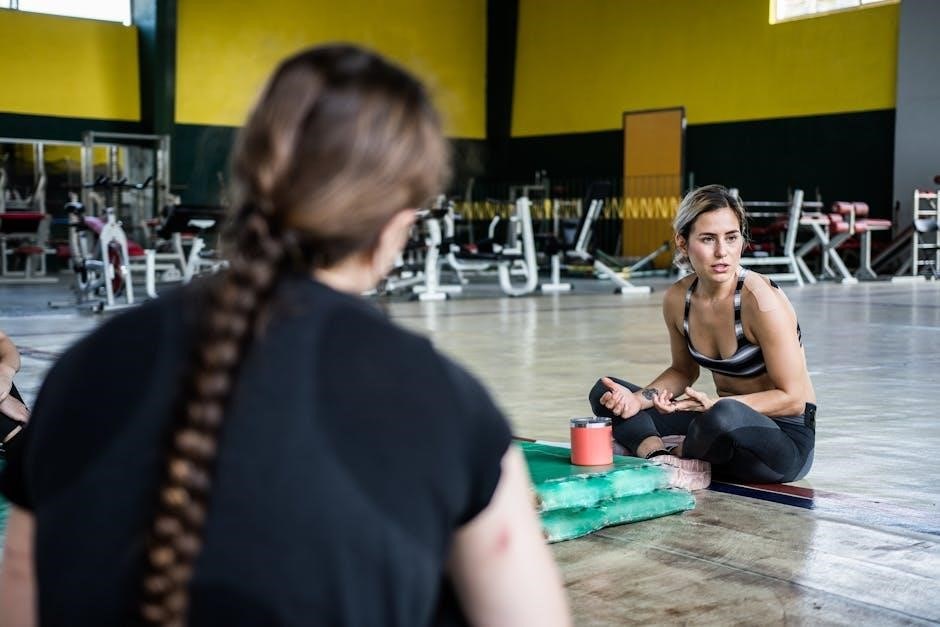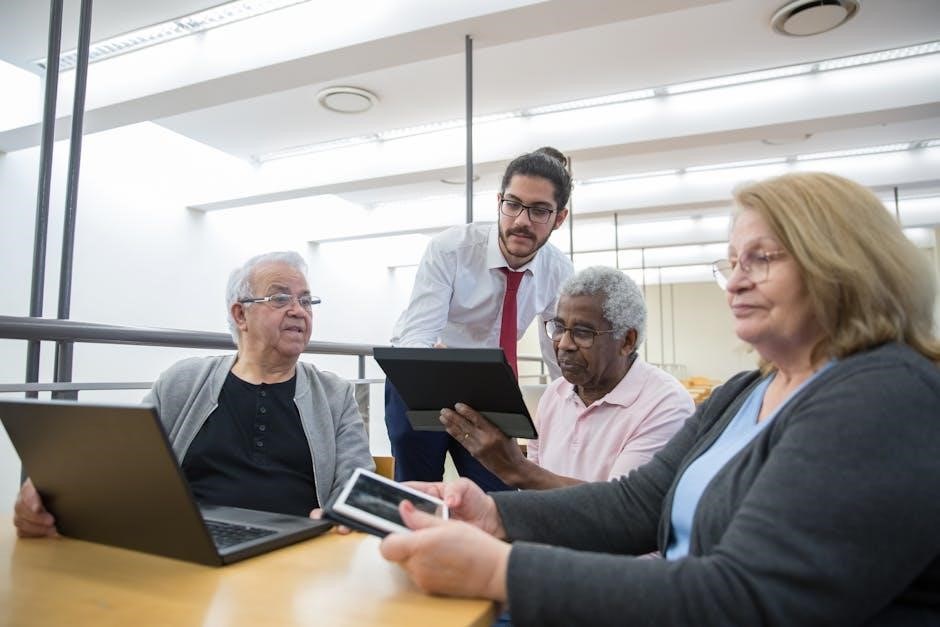Small group instruction is an educational strategy where students are divided into smaller groups to receive personalized learning experiences, fostering active participation and tailored support;
Definition and Overview
Small group instruction refers to a teaching method where students are divided into groups of 8-12 to engage in active learning, allowing them to practice skills, address misconceptions, and receive personalized attention. It often follows lectures, enabling students to apply concepts in a supportive environment. This approach emphasizes flexibility, adapting to the needs of teachers and learners, and can be tailored to various educational settings and objectives.
Historical Context and Evolution
Small group instruction has roots in ancient teaching methods, such as Socratic discussions, emphasizing interactive learning. In the 20th century, educators like John Dewey popularized active, student-centered approaches. The 1980s saw a rise in cooperative learning, formalizing small group strategies. Post-COVID, small group instruction evolved to support equity and accessibility, integrating technology for hybrid learning environments. This adaptability highlights its enduring relevance in education, bridging traditional and modern pedagogical practices.
Key Principles and Objectives
The core principle of small group instruction is personalized learning, allowing teachers to address individual needs and skills. Objectives include fostering active participation, encouraging peer collaboration, and providing immediate feedback. This approach also aims to develop critical thinking and problem-solving skills through guided practice and real-world applications. By tailoring instruction to student readiness and interests, small group instruction creates a supportive environment for academic growth and improved outcomes.

Benefits of Small Group Instruction
Improved academic performance, deeper understanding, and enhanced engagement are key benefits. It supports diverse learners, allowing teachers to address varied needs effectively in a focused setting.
Enhanced Student Engagement
Small group instruction fosters active participation and collaboration, enabling students to engage deeply with material. In smaller settings, students feel more comfortable contributing ideas, leading to higher engagement levels. Teachers can address individual needs, making learning relevant and motivating. Interactive activities, such as discussions and problem-solving tasks, keep students focused and excited about learning. This approach also encourages peer interaction, promoting a sense of community and shared responsibility for academic success. Enhanced engagement leads to improved retention and overall learning outcomes.
Personalized Learning Opportunities
Small group instruction allows teachers to tailor lessons to meet individual student needs, providing personalized learning experiences. In smaller groups, educators can identify and address learning gaps, adapt teaching strategies, and offer targeted support. This approach enables students to progress at their own pace, enhancing their understanding of complex concepts. Personalized learning fosters a more inclusive classroom environment, ensuring that every student receives the attention and resources they need to succeed. This customization of instruction leads to improved academic outcomes and increased student confidence.
Improved Teacher-Student Interaction
Small group instruction enhances teacher-student interaction by allowing educators to engage more directly with each student. In smaller settings, teachers can better understand individual learning styles, provide immediate feedback, and build stronger relationships. This closer interaction fosters a supportive learning environment, encouraging students to ask questions and participate actively. Improved communication between teachers and students leads to better academic performance and a more positive classroom experience, as students feel valued and understood.
Increased Academic Achievement
Small group instruction leads to increased academic achievement by allowing teachers to address individual needs and provide targeted support. Students receive more opportunities to practice skills, receive immediate feedback, and clarify misconceptions. This personalized approach accelerates learning and helps students master concepts more effectively. Research shows that small group settings often result in higher academic performance, as students are more engaged and better supported in their learning journey.

Strategies for Effective Small Group Instruction
Effective small group instruction involves flexible planning, clear goals, and active engagement. Teachers use targeted strategies like differentiated instruction, immediate feedback, and structured routines to maximize learning outcomes.
Lesson Planning and Preparation
Effective small group instruction begins with thorough lesson planning and preparation. Teachers must define clear learning objectives, use data to identify student needs, and prepare tailored materials. Lesson plans should incorporate differentiated instruction, ensuring activities align with student abilities and learning goals. Preparing structured routines, including mentor texts for reading or math problems, helps guide focused discussions. Flexibility is key, as plans may need adjustment based on student responses. Organized preparation ensures smooth transitions and maximizes instructional time, fostering an environment where students can engage deeply with the content.
Grouping Strategies
Effective small group instruction relies on strategic grouping to meet diverse student needs. Teachers can use homogenous or heterogeneous grouping based on student abilities, interests, or learning goals. Homogenous groups allow focused support for students with similar needs, while heterogeneous groups encourage peer learning and collaboration. Data-driven grouping ensures targeted instruction, and flexible grouping allows for periodic changes based on progress. Rotating students through stations or activities also maximizes engagement and ensures personalized attention, making small group instruction adaptable and impactful for all learners.
Managing Classroom Dynamics
Managing classroom dynamics is crucial for effective small group instruction. Establishing clear expectations and routines helps maintain focus and minimize disruptions. Teachers should promote active participation by encouraging collaboration and respectful communication. Strategically arranging the classroom layout can enhance group interactions and reduce distractions. Balancing structure with flexibility ensures smooth transitions between activities. By fostering a positive and inclusive environment, educators can optimize learning outcomes and ensure all students engage meaningfully in small group settings.
Assessment and Feedback
Assessment and feedback are integral to small group instruction, enabling teachers to gauge student progress and understanding. Formative assessments, such as observations and quizzes, help identify learning gaps. Providing immediate, specific feedback allows students to adjust their approach and improve. Data from these assessments informs future instruction, ensuring personalized learning. Regular feedback also helps students track their progress, fostering self-awareness and motivation. By integrating assessment and feedback, educators can refine their strategies and enhance student outcomes in small group settings.

Small Group Instruction in Different Educational Levels
Small group instruction is effective across various educational levels, from elementary to higher education, offering tailored learning experiences that cater to diverse student needs and developmental stages;
Elementary Education
In elementary education, small group instruction is particularly effective for young learners, fostering personalized learning and hands-on activities. It allows teachers to address diverse learning needs, including students with disabilities or English language learners. Small groups encourage collaboration, creativity, and social skills development. Teachers can use data-driven approaches to tailor lessons, ensuring each student receives targeted support. Daily schedules often include designated times for small group work, promoting consistent engagement and progress. This method is especially beneficial for foundational skills like reading and math, helping students build a strong academic base.
Secondary Education
In secondary education, small group instruction is highly effective for addressing the diverse needs of adolescents. It allows for in-depth discussions, problem-solving, and collaborative learning, particularly in complex subjects like STEM. Teachers can target specific skill gaps, fostering a deeper understanding of concepts. Small groups also enable personalized feedback and differentiation, benefiting English language learners and students with special needs. This approach prepares students for real-world applications, encouraging critical thinking and teamwork. Regular small group sessions help bridge learning gaps and enhance academic outcomes in secondary settings.
Higher Education
In higher education, small group instruction is a valuable pedagogical tool that encourages active learning and critical thinking. It allows professors to engage students in discussions, debates, and collaborative problem-solving, fostering deeper understanding of complex topics. Small groups facilitate personalized interaction, enabling students to receive tailored feedback and clarification. This approach is particularly effective in disciplines like STEM, where hands-on applications and peer-to-peer learning enhance retention and innovation. By promoting intellectual exchange, small group instruction prepares students for real-world challenges and lifelong learning in academic and professional settings.

Subject-Specific Applications
Small group instruction is tailored to specific subjects, enhancing learning through targeted activities. Mathematics benefits from problem-solving sessions, while literacy and STEM leverage collaborative, hands-on approaches, fostering subject mastery.
Mathematics
In mathematics, small group instruction allows teachers to address individual learning gaps and provide targeted support. Students engage in hands-on activities and problem-solving tasks, fostering deeper understanding of mathematical concepts. This approach enables teachers to use manipulatives, real-world applications, and technology to enhance learning. Differentiated instruction ensures that each student receives tailored challenges and scaffolding, making math more accessible and enjoyable. Regular formative assessments help track progress and adjust teaching strategies, ensuring all students meet their learning goals effectively in a collaborative environment.
Reading and Literacy
Small group instruction in reading and literacy enables teachers to provide focused support, tailoring lessons to students’ specific needs. Guided reading activities, phonics practice, and comprehension strategies are effectively delivered in smaller settings. This method allows for immediate feedback, fostering confidence and fluency. Teachers can also incorporate mentor texts and leveled readers to match students’ abilities, ensuring personalized learning. Regular assessments help identify progress and areas for further support, making small group instruction a powerful tool for improving literacy skills and engaging students in meaningful reading experiences.
Science, Technology, Engineering, and Math (STEM)
Small group instruction in STEM subjects fosters hands-on exploration and collaborative problem-solving. Students engage in project-based learning, applying concepts across disciplines. Teachers can tailor activities to meet diverse learning needs, encouraging critical thinking and innovation. This approach enables personalized feedback and enhances understanding of complex ideas. Integrating technology, such as simulations or digital tools, further enriches learning experiences, preparing students for real-world challenges in STEM fields.
Language Learning
Small group instruction in language learning provides opportunities for personalized feedback and interactive practice. Students engage in role-playing, conversational exercises, and targeted vocabulary building. This approach allows teachers to address diverse proficiency levels and learning styles. By fostering meaningful communication, small groups enhance fluency and cultural understanding. Integrating digital tools, such as language apps, further supports immersive learning experiences, making language acquisition more engaging and effective for all students.

Technology Integration in Small Group Instruction
Technology enhances small group instruction by providing interactive tools, personalized resources, and real-time feedback, fostering engagement and tailored learning experiences for diverse student needs.
Online Tools and Platforms
Online tools and platforms are essential for enhancing small group instruction, offering interactive and collaborative learning experiences. Platforms like Google Classroom, Zoom, and Kahoot enable real-time interaction, while Learning Management Systems (LMS) organize resources and track progress. These tools facilitate personalized learning, allowing teachers to tailor content to meet diverse student needs. They also support engagement through multimedia resources, quizzes, and discussions. By leveraging these technologies, educators can create dynamic and inclusive learning environments that foster collaboration and academic success in small group settings.
Blended Learning Approaches
Blended learning combines traditional face-to-face instruction with digital tools to create flexible learning environments. In small group settings, this approach allows students to engage with online resources and activities before or after group sessions. Teachers can use pre-recorded videos, interactive simulations, and online quizzes to supplement instruction. This method supports differentiated instruction, enabling students to learn at their own pace while maintaining meaningful teacher-student interaction. Blended learning enhances engagement and personalizes the learning experience, making it a valuable strategy for effective small group instruction.
Digital Resources and Multimedia
Digital resources and multimedia tools enrich small group instruction by providing interactive and engaging learning experiences. Teachers can use educational videos, interactive simulations, and online platforms to present concepts in a visually appealing manner. Multimedia elements such as audio recordings and animations can cater to diverse learning styles, enhancing understanding and retention. Additionally, digital tools like Kahoot and Quizlet can be used for formative assessments, while collaborative platforms like Google Docs enable real-time group work. These resources make learning dynamic and accessible, fostering deeper student engagement and collaboration.

Cultural and Linguistic Considerations
Cultural and linguistic diversity require tailored approaches in small group instruction to ensure inclusivity and equitable learning opportunities for all students, fostering a supportive and responsive environment.
Diverse Learner Needs
Small group instruction is particularly effective in addressing the diverse needs of learners, including students with special needs, English language learners, and those requiring additional support. By allowing teachers to tailor instruction to specific skill levels and learning styles, small groups create a more inclusive environment. This approach enables targeted interventions, fostering academic growth and confidence. Assessments and data can guide group formation, ensuring personalized attention. Additionally, small groups encourage peer collaboration, reducing anxiety and promoting engagement among learners with varied abilities and backgrounds.
Culturally Responsive Teaching
Small group instruction aligns with culturally responsive teaching by allowing educators to tailor lessons to students’ diverse cultural backgrounds and experiences. Teachers can incorporate diverse texts, discussions, and activities that reflect students’ identities, fostering a sense of belonging. This approach encourages inclusive dialogue, where students feel valued for their unique perspectives. By integrating cultural responsiveness into small group settings, educators promote equity, deepen understanding, and create a supportive environment for all learners, regardless of their cultural or linguistic background.
Supporting English Language Learners
Small group instruction is particularly effective for English language learners (ELLs), as it provides tailored support to overcome language barriers and build academic skills. Teachers can use scaffolding techniques, visual aids, and simplified language to ensure comprehension. This setting allows ELLs to practice speaking, listening, and writing in a less intimidating environment. Differentiated instruction within small groups enables teachers to address varying proficiency levels, fostering language development while integrating content learning. Regular interaction with peers and teachers enhances confidence and accelerates language acquisition for ELLs.

Classroom Management Tips
Establish clear routines for small group instruction, ensuring consistency and minimizing disruptions. Balance structured activities with free play to maintain focus and engagement among students.
Creating a Conducive Learning Environment
A well-organized classroom layout minimizes distractions, allowing students to focus during small group instruction. Ensure workspaces are accessible and materials are within reach. Use visual schedules to clarify expectations and transitions, promoting a sense of structure. Incorporate positive reinforcement techniques to encourage engagement and respect among students. Flexible seating options can enhance collaboration, while designated areas for independent and group work maintain clarity. A calm and orderly environment fosters academic success and supports diverse learning needs during small group activities.
Behavioral Management Strategies
Establishing clear expectations and routines is essential for managing behavior during small group instruction. Use visual reminders and positive reinforcement to encourage productive behavior. Proactive strategies, such as redirecting off-task actions and providing individual support, help minimize disruptions. Creating a respectful and focused environment ensures students stay engaged and motivated. Consistent reinforcement of behavioral expectations fosters accountability and promotes a positive learning atmosphere, enabling students to thrive in small group settings.
Time Management Techniques
Effective time management is crucial for successful small group instruction. Allocate specific time slots for each group, ensuring consistent rotations to maximize engagement. Use timers or visual cues to maintain focus and transitions. Prioritize activities based on student needs and learning goals. Implement a structured schedule with clear start and end points for each session. Regularly monitor progress to adjust pacing as needed, ensuring all students receive adequate support. Balancing structure with flexibility allows for efficient use of instructional time while addressing individual needs.

Professional Development for Teachers
Professional development for teachers involves workshops, training, and peer feedback to enhance small group instruction skills, ensuring effective implementation and fostering continuous improvement.
Workshops and Training Programs
Workshops and training programs are essential for enhancing teachers’ skills in small group instruction. These programs often include hands-on activities, lesson planning strategies, and techniques for managing diverse learners. Teachers learn how to effectively use data to drive instruction and differentiate learning experiences. Training also covers technology integration and culturally responsive teaching practices. Peer feedback and collaborative learning are emphasized to foster professional growth. These workshops ensure educators are well-equipped to implement small group instruction effectively, addressing the unique needs of all students and promoting academic success.
Peer Observations and Feedback
Peer observations and feedback are valuable tools for improving small group instruction. Teachers observe each other’s sessions, providing constructive insights on lesson delivery, student engagement, and classroom management. This collaborative approach fosters a culture of continuous improvement, allowing educators to refine their strategies and adapt best practices. Regular feedback sessions help identify strengths and areas for growth, ensuring that small group instruction remains effective and aligned with student needs. This professional exchange enhances teaching quality and supports overall educational goals.
Continuous Improvement Practices
Continuous improvement practices are essential for refining small group instruction. Teachers can reflect on lesson outcomes, analyze student progress, and adjust instructional strategies accordingly. Leveraging data from assessments and feedback helps identify areas needing enhancement. Professional development opportunities, such as workshops and peer discussions, further support educators in refining their techniques. By consistently evaluating and updating methods, teachers ensure that small group instruction remains dynamic and effective, catering to diverse student needs and fostering academic success.

Resources and References
Access comprehensive guides, research studies, and online forums dedicated to small group instruction, offering practical strategies and evidence-based practices for educators.
Recommended Reading and Guides
Explore essential guides and research studies on small group instruction, such as “Small Group Teaching and Learning: Method and Effect to Student Learning Achievement” and “Differentiated Mathematics Centers in P-3 PDF.” These resources provide practical strategies, evidence-based practices, and innovative approaches to enhance classroom effectiveness. Webinars like “Using Small Groups to Teach Content and Language Integrated Learning (CLIL)” offer tips and examples for implementation. Additionally, publications from Solution Tree Press and Illinois ASCD provide actionable insights for educators seeking to improve small group instructional methods.
Research Studies and Journals
Research studies highlight the effectiveness of small group instruction across various educational levels. A study by Degi Alrinda Agustina (2022) explores its impact on student learning achievement, while AI Dashkina (2024) examines competition in small groups to enhance motivation in foreign language learning. Additionally, research from the University of Michigan demonstrates how small-group instruction outside school improves math skills for kindergarten students. These studies provide valuable insights into designing and implementing small group instruction, offering evidence-based strategies for educators to enhance student outcomes and engagement in diverse learning environments.
Online Communities and Forums
Online communities and forums provide valuable resources and support for educators implementing small group instruction. Platforms like ResearchGate, SolutionTree.com, and Illinois ASCD offer access to free reproducibles, webinars, and forums where teachers share strategies and best practices. These spaces facilitate collaboration, allowing educators to discuss challenges, exchange ideas, and access evidence-based resources. They also host discussions on topics like differentiated instruction, classroom management, and technology integration, helping teachers refine their small group instruction practices and stay updated on the latest educational trends and research.
